Anyone making milk kefir on a regular basis will occasionally end up with curds and whey. Though it’s usually the result of over-culturing, it is also a great way to make kefir cheese! Here’s everything you need to know about making this probiotic soft cheese and milk kefir whey.
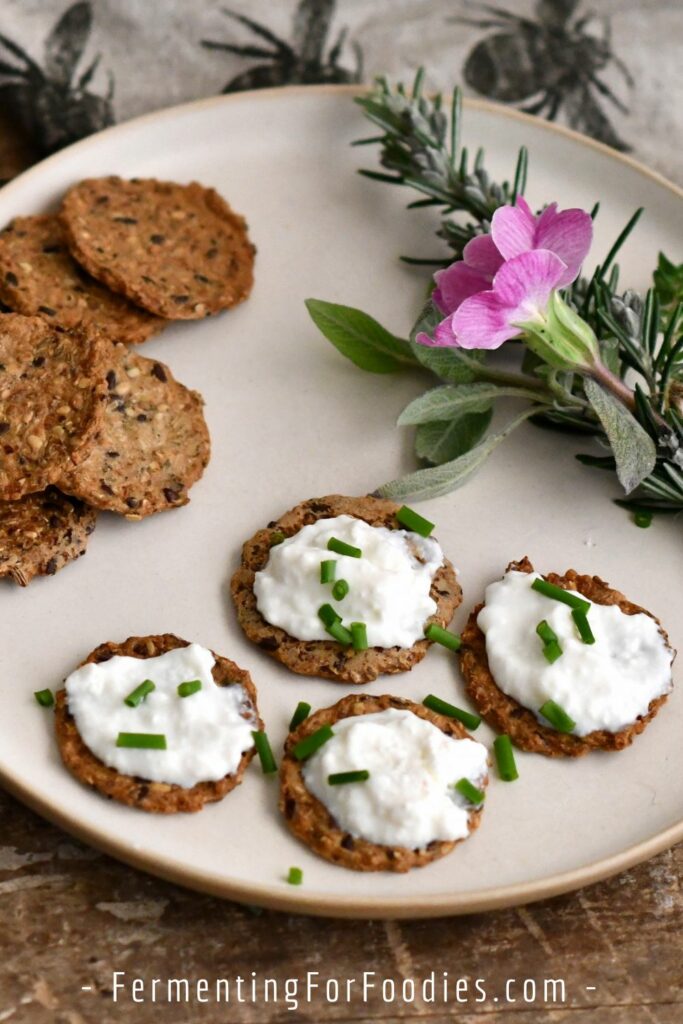
Why does milk kefir form curds?
Acidity causes casein protein in dairy to form curds. It doesn’t matter whether the acidity comes from vinegar, lemon juice, rennet, or bacterial culture. So as kefir acidifies, it naturally separates into curds in whey.
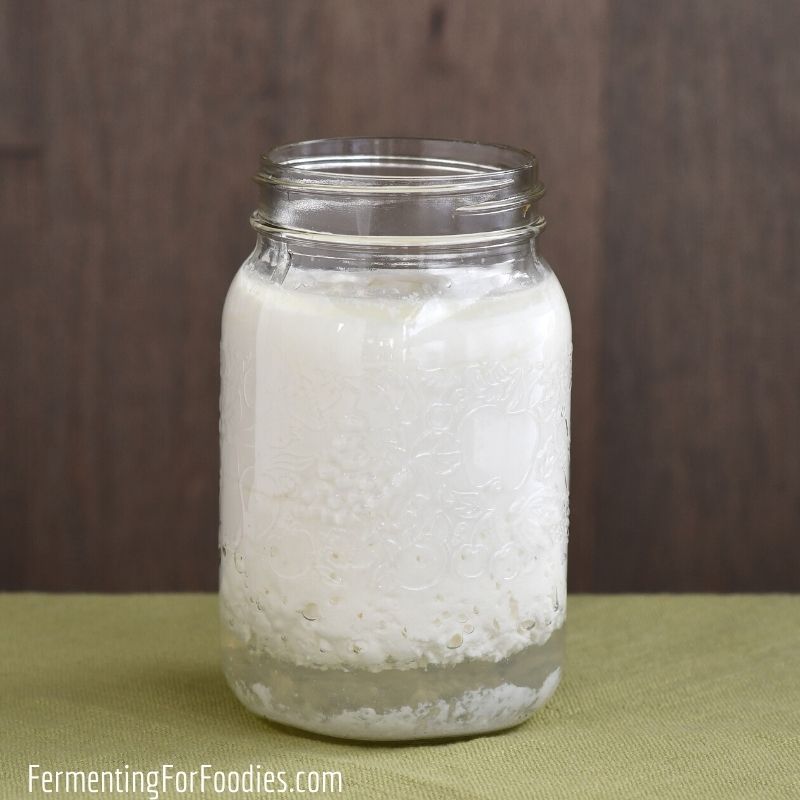
Here are the main reasons why kefir separates:
- The ratio of kefir grains to milk is off. Check out this post on how to culture milk kefir for the proper ratio of grains to milk.
- The milk kefir was cultured too long. It’s best to store your kefir in the fridge if you’re going away on holiday or you can take it with you.
- Temperature also plays a role in how quickly milk kefir separates.
In general, I usually let the kefir milk curd AFTER I’ve removed the kefir grain. However, occasionally I accidentally make separated milk kefir while culturing. Either way, the cheese is delicious!
Separating curds and whey
Here are the steps to separating curds and whey for making cheese.
- Strain the curded kefir through two layers of cheesecloth. I recommend saving the kefir whey as it’s packed full of protein and probiotics. I often make kefir cheese just because I want to use the whey. It’s great for soaking grains or making soda pop.
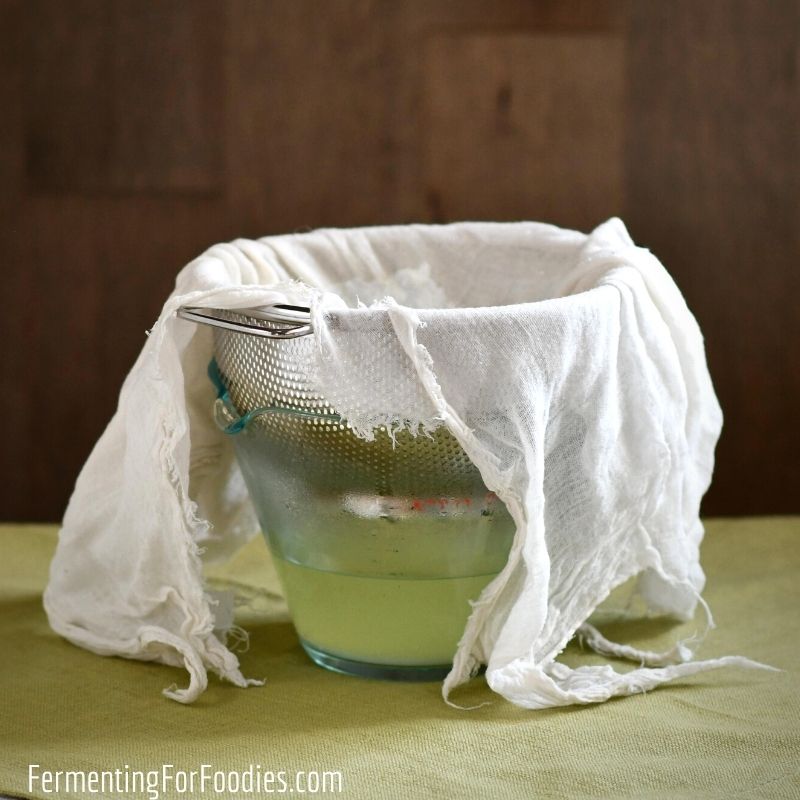
- After the whey has drained for about 30 minutes, gather up the ends of the cheesecloth and knot it together around a wooden spoon, and hang it so it can drain some more.
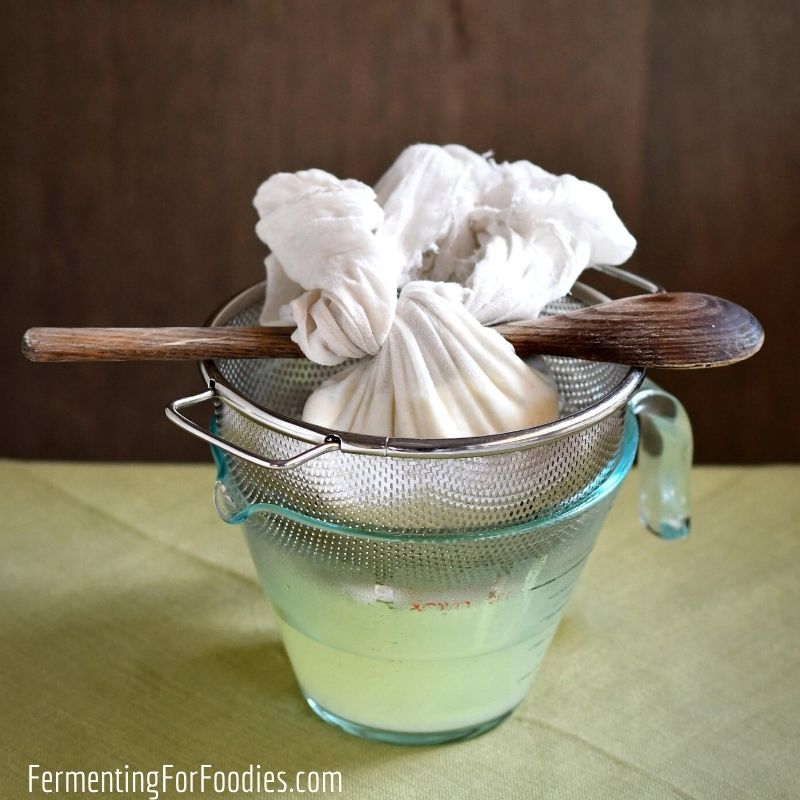
- Here’s what the ball of cheese looks like after 6 hours of hanging. It’s firm on the outside, but still quite soft inside. At this point, finish your cheese by mixing in some salt and any additional flavors.

What can you do with kefir cheese?
Kefir cheese is soft, creamy, and slightly tart. It is a versatile, simple cheese that can be used in all sorts of different ways.
Here are a few different ways to use homemade cheese:
- Make a savory cream cheese spread. See below for flavor options.
- Use it as a substitute for ricotta in lasagna.
- It’s perfect for sweet treats like kefir cheese frosting or kefir cheesecake.
- Make a firm feta-like cheese by pressing more whey out of the cheese.
Flavor options
My favorite way to enjoy kefir cheese is by turning it into a flavorful cheese spread. It’s perfect spread in sandwiches, on bagels, or on crackers as an afterschool snack!
To flavor kefir cheese, simply add herbs and other savory flavors when you mix in the salt. The let the kefir cheese rest for at least an hour before serving so that the flavors can blend in.
Here are a few of my favorite flavor combinations:
- 1/4 cup of chopped chives and 1 Tbsp of olive oil
- 1 clove of garlic and 1/4 cup of fresh basil, finely diced
- 1/4 cup of fresh dill
- Use mixed herbs for a Boursin flavored kefir cheese
- Herb-marinated kefir cheese balls are a fun appetizer.
Homemade Kefir Cheese
Kefir cheese is a delicious soft cheese that is a lot like soft goat cheese. It’s easy to make, all you have to do is let your kefir culture for long enough that it separates into the curds and whey! See the section above for a few ways to enjoy this delicious and probiotic cheese.
- Prep Time: 20 minutes
- Total Time: 20 minutes
- Yield: 2 cups of cheese 1x
- Category: Cheese
- Method: Fermented
- Cuisine: Probiotic
- Diet: Vegetarian
Ingredients
- 1 liter of milk
- 2 Tbsp kefir grains
- 1/4 tsp of salt (non-iodized)
Instructions
- Culture the milk with kefir grains for 12 to 24 hours. Remove the grains from the cultured milk. At this point, the kefir won’t have fully separated into curds and whey, so leave it on the counter (without the grains) for another 12-24 hours until it has fully separated. (See photo above).
- Line a colander with two layers of cheesecloth (I recommend fine cheesecloth). Gently pour the curded kefir into the colander. Allow it to drain for 30 minutes. I recommend catching the whey because it’s very useful and probiotic!
- Knot the cheesecloth and hang the ball of kefir cheese, as shown in the photo above. Allow to drain for another 4-8 hours.
- Unknot the cheesecloth and place the soft cheese in a bowl or a container. Stir in the salt and any additional flavors. See the section above for a few different options for finishing the kefir cheese.
- Store kefir cheese in an air-tight container in the refrigerator. Use the cheese within 2 weeks, as it will continue to sour and ferment.
Notes
- I recommend using whole milk for kefir cheese as it is a bit creamier than skim milk cheese.
- Kefir cheese is tastier when it’s not made with over-cultured kefir. However, if you accidentally overculture your kefir (before you remove the grains) just remove the grains, and let your kefir sit for another 2 to 4 hours separate again before draining the whey.


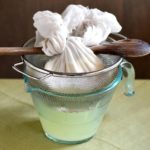
This looks interesting for sure! Thank you so much for sharing. I’m gonna try and recreate this kefir cheese at home!
Great! I just made some yesterday. 🙂
Were do you get your starter I tried to get it from health food stores but they have never heard of it and won’t help me get it. I’m living in Ontario Canada.please can you help me thank you . Diana
Hi Diana,
Kefir grains can be hard to find. I recommend either looking for a fermenting culture sharing board (my community has one on Facebook) or buying it online. Once you have the kefir grain, you will have to keep culturing it. It’s more like a pet then a one-time use cheese culture. Here’s a few posts on kefir and other simple cheeses that can be made without kefir grains:
https://www.fermentingforfoodies.com/archives/192
https://www.fermentingforfoodies.com/archives/1761
https://www.fermentingforfoodies.com/archives/category/products/cultures
Good luck!
Hi Diana! i got mine from amazon.ca. best of luck
Karine
You can order kefir grains on Amazon ,it grows fast and soon you will be sharing!
Thank you very much for this recipe!!!
Great recipe I’ll try this- I’m loving this new “culture”, but my first 2 batches definitely were off-ratio because they separated: a combination of too little milk and too long. I’m trying to get the ratio right such that I use the kefir just in time for the next batch so the grain lives outside at room temp mostly. It’s such a learning experience!
Great! It’s a bit of an art… temperature, time and milk to grain ratios all matter. Glad the little guy is working out for you!
Do you have any suggestions for using the whey for not sweet recipes? It looks like the link you posted is for all sweet whey and not acid..
I make kefir cheese at least once a month… often just for the whey! I use the whey for culturing other ferments, particularly vegetables and condiments. I also use whey for cultured baking (like buttermilk). However, our favourite way to use kefir whey is to make my cultured granola. It’s pretty much what we eat for breakfast every day. I think the only thing on that list that you can’t do with acid whey is to make whey cheese. Hope some of these ideas inspire you!
Hi Emilee, could you please explain what you mean by culturee granola? I’m learning about kefir and cultured food for health. I appreciate you sharing.
Sure! We use it to make granola (nearly monthly!) We culture the oats before roasting, and it makes the oats crunchy without any additional sugar. You can find my recipe here: https://www.fermentingforfoodies.com/fermented-granola/
Hi! I removed the grains from the milk kefir five minutes ago and thought I could actually make kefir cheese. So I looked it up and found your post. I am fermenting another batch right now. I think I’m going to make that one kefir cheese. Thanks for the recipe and the tips
Great! Best of luck! We particularly love flavouring our kefir cheese with herbs. Cheers, Emillie
I’m more interested in that incredible looking bread. What is it?
I’ve photographed this cheese a few times. The first piece of bread was my GF sandwich bread. The second picture is a Raincoast Crisps… which you might be able to buy, depending on where you live. They’re fairly pricey, however, it’s worth it!
The kefir doesn’t really separate without the grains.
Suggestions why that is? Should i wait longer? Or is there a way to separate curd and grains?
Thanks
Hum… my kefir does tend to separate after an extra 24 hours on the counter without the grains. However, I know there are different varieties of kefir, so that might be the issue? Do you have the small bead-like grains? Or the single larger grain. I’m not sure what to suggest if you have the smaller grains, however, you should be able to remove a larger grain after separating. Cheers!
Thanks. I see it separating now. Took 36 hrs or so.
Great!
Trying this tonight after leaving my kefir 12 hours too long! Wish me luck I love the idea of a homemade ricotta. I’m thinking of trying homemade cheese stuffed ravioli with it??
Yum! Just make sure to drain most of the whey as kefir is tangy and sour compared to ricotta.
I have some very seperated kefir as it got left behind in the fridge. Do you think ok to use or bin it?
It should be fine to use. It may be quite sour, depending on how long it was in there. Regardless, it’s perfect for making kefir cheese! If you find it too sour, try flavoring it with herbs and garlic. Enjoy!
I drink it right out of the jar even if it’s more sour, my wife looks at me like I’m crazy. She drinks hers like a small child taking medicine lol.
🙂
I unintentionally ended up with a lot of curd and want to make cheese. How do I rescue my grains?
If you have the large style kefir grain, then you should be able to remove it before straining. It should be fairly obvious and hopefully floating on top. However, if you have small, pearl-like grains, then you will need to mix up your kefir curds and strain to remove the grains. Then let the curds form again, to make cheese. After that, put the grains in fresh milk for the next batch of kefir.
Enjoy!
Totally loved the chive and olive oil.
Thank you
I love flavored kefir cheese too! 🙂
Hello,
I just found your amazing site yesterday. I live in the UK so I’m hoping I can find all what I need to ferment! I would really like to purchase the book ‘Fermenting made easy’ Please could you tell me if that’s possible from where I live and if so how do I go out it? Many tanks and thank you for all the knowledge you post on here.
Hi Jackie,
Fermenting Made Simple is available with online sellers (amazon, book depository). It might also be available from some UK bookstores. A quick google search turned up Blackwells, so perhaps google it? I’m sure you can find what you need to ferment in the UK! I’ve met quite a few fermentation enthusiasts from the UK. Happy Fermenting! Emillie
Thank you for this recipe! I’m letting my kefir cheese drain right now and I am wondering if this is supposed to be done in the fridge or counter? Sorry if you mentioned it above, I looked but couldn’t find the answer. If you have a chance I’d love to know ❤️
You can do it either way. I usually drain on my counter because there isn’t enough room in my fridge. But it’s fine to drain in the fridge if you want. Cheers!
Thank you! I did it on my counter and added basil and garlic and it was amazing! Put it on some homemade bagels! I’m new to this and appreciate the time you take to share your knowledge ❤️
Yum! Basil and garlic sounds delicious. Glad you are enjoying your homemade cheese!
Is the kefir made with milk or water grains.
This is made with milk kefir grains. They’re different from water kefir grains, as they specifically feed on lactose. Cheers!